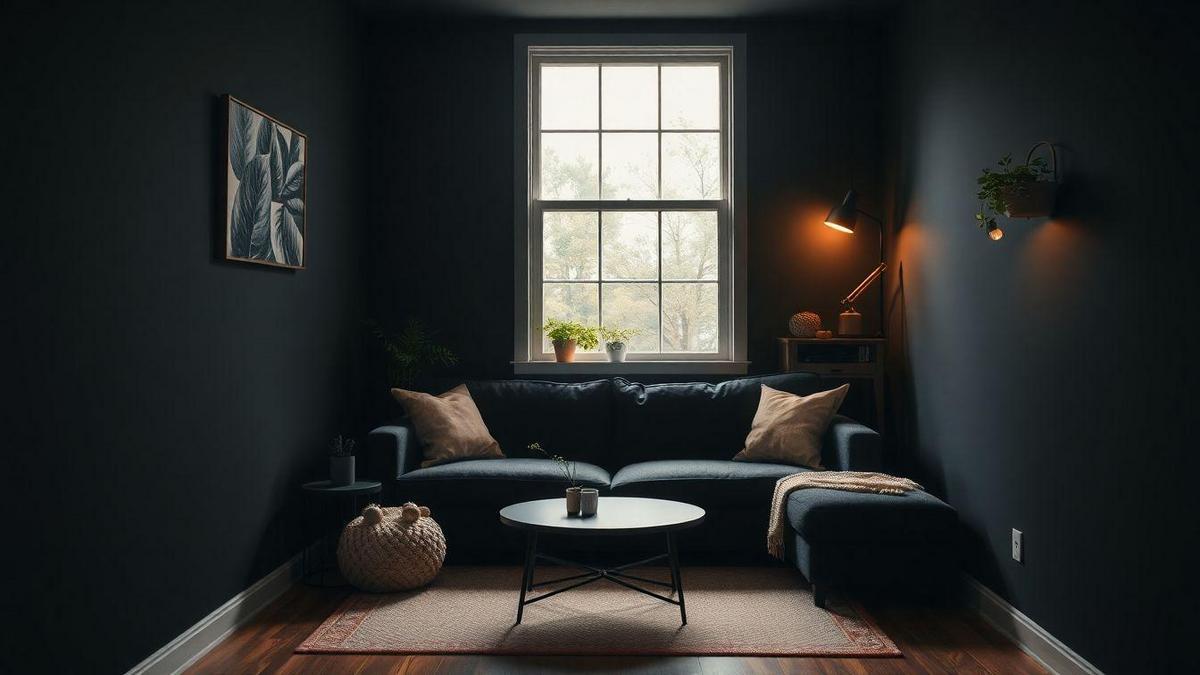When it comes to your small living room, color can make a big difference! In this article, you’ll discover how to use the psychology of colors to create a cozy vibe. We’ll dive into balancing neutrals with fun accents for that needed depth. Plus, you’ll find out if dark colors can fit into your space without making it feel cramped. Get ready to learn how to choose the perfect colors for your small living room!
Important Points to Remember
- Light colors make the room feel bigger.
- Choose 2-3 colors for a cohesive look.
- Use accent colors to add interest.
- Test paint samples on your walls.
- Stick to your style and preferences.

Understanding the Psychology of Colors in Interiors
Colors are more than just pretty shades on the walls; they can affect your mood and influence your feelings. When you’re designing a small living room, the colors you choose can make all the difference. Let’s dive into how colors can change the vibe of your space and help you feel at home.
The Basics of Color Psychology
Each color has its own personality. Here’s a quick rundown:
| Color | Mood/Feeling |
|---|---|
| Red | Passion, energy, warmth |
| Blue | Calm, trust, serenity |
| Yellow | Happiness, cheerfulness, creativity |
| Green | Balance, nature, freshness |
| Purple | Luxury, creativity, mystery |
| Orange | Enthusiasm, warmth, friendliness |
| White | Cleanliness, simplicity, peace |
| Black | Sophistication, elegance, power |
When you’re choosing colors for your small living room, think about what feelings you want to evoke. Do you want it to be a cozy retreat? Or maybe a lively space for gatherings?
How Colors Work Together
It’s not just about picking one color. You can mix and match to create a harmonious look. Here are some tips:
- Complementary Colors: Colors opposite each other on the color wheel, like blue and orange, create a striking contrast.
- Analogous Colors: Colors next to each other on the color wheel, like blue, blue-green, and green, create a soothing effect.
- Monochromatic Colors: Using different shades of the same color can create depth without overwhelming the space.
Real-Life Examples
Imagine walking into a small living room painted in soft blue. You instantly feel calm, right? Now picture a room with bright yellow accents. It’s cheerful and inviting!
One homeowner painted their small living room a warm beige and added teal cushions. The beige made the room feel larger, while the teal brought in a pop of color without being too loud.
Tips for Your Small Living Room
- Light Colors: Light shades like soft whites or pastel tones can make your small living room feel bigger.
- Accent Walls: Choose one wall to paint a bold color. It draws the eye and adds interest without overwhelming the space.
- Use Accessories: If you’re not ready to paint, use colorful pillows, rugs, or artwork to bring in color. Consider exploring various decor ideas for inspiration.

Balancing Neutrals with Accents for Depth
When you’re decorating your small living room, finding the right balance between neutral colors and accent shades can make all the difference. You want your space to feel inviting and stylish, right? So, let’s dive into how you can achieve that perfect mix!
Why Neutrals Matter
Neutrals are your best friends. They create a calm backdrop that allows other colors to pop. Think of them as the canvas for your masterpiece. Here are some popular neutral colors:
- Whites
- Beiges
- Grays
- Soft Taupes
These shades can make your small living room feel larger and more open. Imagine walking into a room that feels airy and fresh. That’s the magic of neutrals!
Adding Accents: The Fun Part!
Now, let’s talk about accents. This is where you can let your personality shine! Accent colors are like the cherry on top of your sundae. They bring life and energy to your space. Here’s how to choose them:
- Pick a Color Scheme: Choose 1-3 accent colors that you love. For example, if your walls are a soft gray, you might choose bright yellow and deep blue for your accents.
- Use Accessories: Add throw pillows, artwork, or rugs in your accent colors. These small touches can make a big impact. Explore more small space design concepts for additional ideas.
- Be Bold: Don’t be afraid to use a vibrant color! A bright red chair or a funky green lamp can become the star of your small living room.
Creating Depth with Layers
Layering is key when balancing neutrals and accents. Think of it like adding ingredients to a stew. Each layer adds flavor and depth. Here’s a simple breakdown:
| Layer Type | Example |
|---|---|
| Base Layer | Neutral sofa and walls |
| Middle Layer | Accent pillows and throws |
| Top Layer | Artwork and decorative items |
By mixing these layers, you create a rich and inviting atmosphere. It’s like building a cozy nest!
Real-Life Example
Let’s say you have a small living room with beige walls. You might choose navy blue for your accent color. Add a navy blue throw blanket on your neutral couch, some bright yellow pillows, and a piece of artwork that ties it all together. Suddenly, your space feels warm, inviting, and full of personality!

Can Dark Colors Work in Small Spaces Without Feeling Cramped?
Absolutely! Dark colors can add depth and character to your small living room without making it feel cramped. Think of it this way: a small space painted in rich, dark hues can feel cozy and inviting—like a warm hug. Here are some tips to help you use dark colors effectively.
Use Light Accents
When you go dark, balance it out with light accents. This could be:
- Light-colored furniture
- Bright throw pillows
- White or light curtains
These elements help to create contrast, making the space feel more open. Imagine a dark blue wall paired with a white sofa—it’s striking yet inviting!
Choose the Right Dark Color
Not all dark colors are created equal. Some colors can make a room feel heavy, while others can create a sense of elegance. Here’s a quick guide:
| Color | Effect |
|---|---|
| Navy Blue | Calm and sophisticated |
| Charcoal Gray | Modern and chic |
| Deep Green | Nature-inspired and refreshing |
| Rich Burgundy | Cozy and warm |
Lighting Matters
Good lighting can work wonders. Use a mix of ambient and task lighting. Consider:
- Floor lamps for soft, warm light
- Wall sconces to highlight artwork
- Table lamps for reading nooks
This way, your small living room won’t feel like a cave, even with dark colors! For more lighting tips, check out our lighting tips.
Mirrors Are Your Best Friend
Mirrors can create the illusion of space. A large mirror on a dark wall can reflect light and make the room feel bigger. It’s like opening a window to another world!
Keep It Simple
When using dark colors, keep your decor simple. Too many items can make the space feel cluttered. Stick to a few key pieces that you love. This way, your small living room will feel more open and less chaotic.
Conclusion
In wrapping up, remember that color is your secret weapon in transforming your small living room into a cozy haven or a lively gathering spot. By understanding the psychology of colors, you can evoke the right moods and feelings that resonate with you. Don’t shy away from experimenting with neutrals and accent colors—they’re like the perfect duet in a song, creating harmony and depth.
And if you’re considering dark hues, just know they can work wonders when paired with the right lighting and accessories. So, go ahead and paint your space with boldness and creativity!
If you’re hungry for more insights on making the most out of your small living room, check out more articles at Simple Small Space Living. Happy decorating!
Frequently Asked Questions
How can I make colors work in my small living room?
Choose lighter shades. They help create a bigger feel. Don’t forget to mix textures too for depth.
What are the best color schemes for a small living room?
Try a combination of soft neutrals and one bold color. This keeps it bright yet lively. For more ideas, check our guide on best color schemes for small apartments.
Should I stick to one color in a small living room?
No! Use a palette of 2-3 colors. It adds interest without feeling cluttered.
How do I know if a color is too dark for my small living room?
Test it with samples. If it makes the room feel cramped or gloomy, choose lighter tones.
Can I use patterns in a small living room?
Yes! Just be careful. Use small patterns and balance them with solid colors. This keeps it from overwhelming the space.

